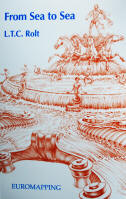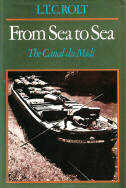From Sea to Sea: The Canal du Midi
Revised paperback edition published by Euromapping (includes new material by David Edwards May), 1994
US edition by Ohio University Press, 1974
First edition by Allen Lane, 1973
How to buy
Tom Rolt's
From Sea to Sea: The Canal du Midi is the history of the 17th century French canal that was to inspire the Duke of Bridgewater's canal in England in the next century.
The Canal du Midi was built in just fifteen years from 1666 to 1681, to provide an inland water route through Southern France between the Atlantic and the Mediterranean.
In recent years the tree-lined canal has become one of the major tourist attractions in South West France and in 1996 it was declared a Unesco world heritage site.
Writing in 1972, Rolt tells us how this extraordinary engineering achievement was inspired and led by Pierre Paul Riquet, a provincial tax collector, how he won the support of Louis X1V, and how he overcame formidable technical, economic and social problems to accomplish what is now appreciated as one of the most graceful of canals to be found anywhere in the world.
Part of the interest in the book is that it provides an image of the canal at a time (1972) when works were proceeding apace on the lengthening of locks and building the water slope at Montech, signs that there might be a future for waterborne freight transport. The option to modernise the Canal du Midi intrigued Rolt, who had always been a passionate advocate of the potential practical utilitarian use for waterways.
David Edward-May, writer of books and guides on European waterways, brings the story up to date, with a postscript describing the decline and more recent renaissance of the canal as tourist destination. He has also added maps, plans and drawings to make the book the indispensable companion for visitors discovering the canal today.
"Thanks to the unique privileges granted by Louis X1V to Riquet and his heirs, he deliberately set out to create what, in modern planner’s jargon, would be called a linear park…No financial stringency, no engineering problem however intractable it might appear, was permitted to override aesthetic judgement on matters of landscaping or architecture. Hence Riquet’s great canal has become an eloquent memorial of an age when the marriage of the arts and sciences, of beauty with utility, was taken for granted and their divorce inconceivable."
L T C Rolt - Sea to Sea (p 180)

